Project Plan: Role of Engineers in Sustainable Development - BUSN20019
VerifiedAdded on 2023/06/09
|17
|2878
|417
Report
AI Summary
This report presents a project plan that examines the crucial role of engineers in sustainable development. The introduction defines sustainable development and its importance, particularly within the engineering field, emphasizing the need to balance present requirements with future needs. The report outlines the project's aim, which is to identify and discuss the role of engineers in sustainable development, focusing on resource management and societal development. A literature review supports the project, emphasizing the increasing need for sustainable structural design. The project employs secondary data collection methods and quantitative data analysis to assess resource usage and the impact of engineering practices. The report includes a Gantt chart to illustrate the project timeline and feasibility analysis to determine the project's viability. Overall, the project underscores the engineers' responsibility to develop innovative technologies that benefit future generations and preserve resources, aligning with the principles of sustainable development.
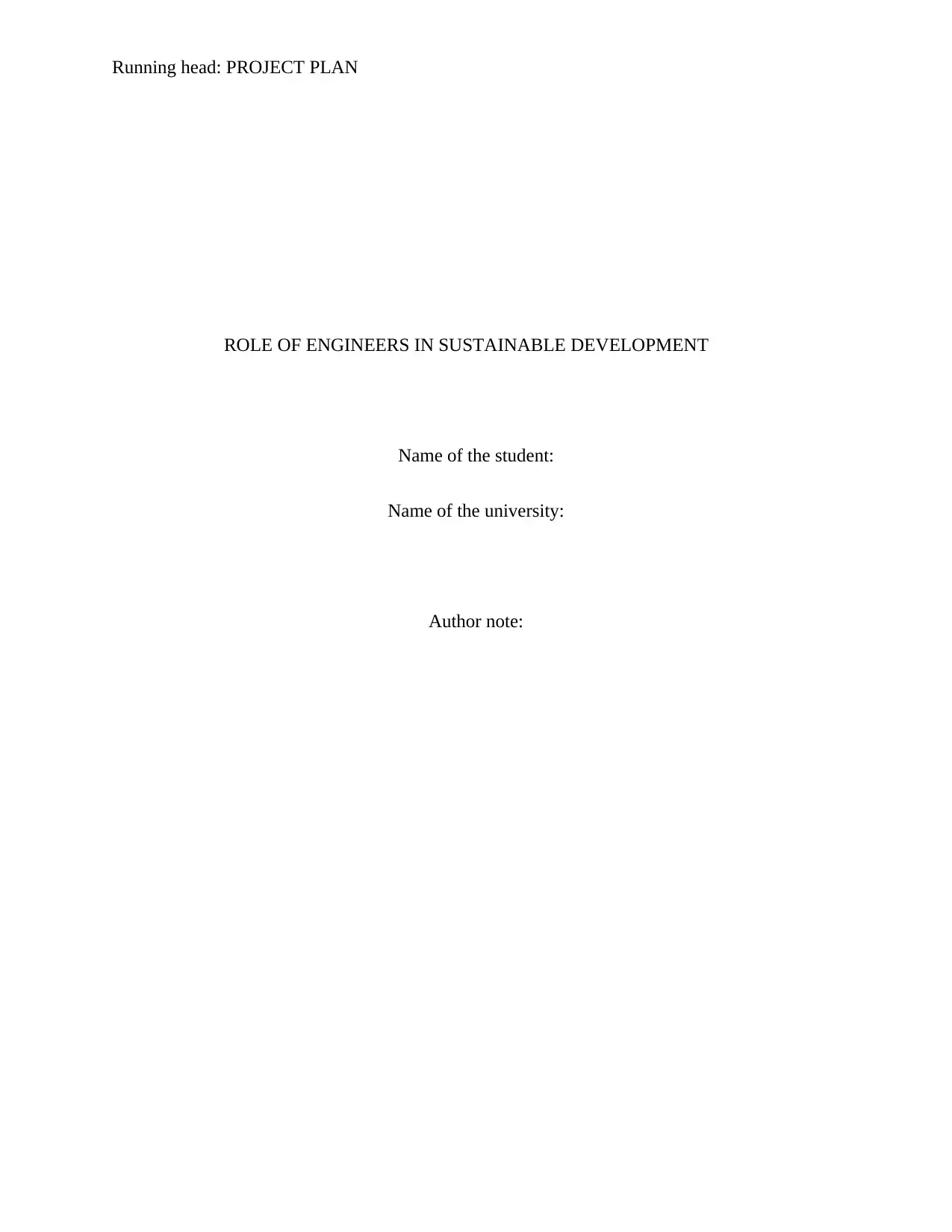
Running head: PROJECT PLAN
ROLE OF ENGINEERS IN SUSTAINABLE DEVELOPMENT
Name of the student:
Name of the university:
Author note:
ROLE OF ENGINEERS IN SUSTAINABLE DEVELOPMENT
Name of the student:
Name of the university:
Author note:
Paraphrase This Document
Need a fresh take? Get an instant paraphrase of this document with our AI Paraphraser
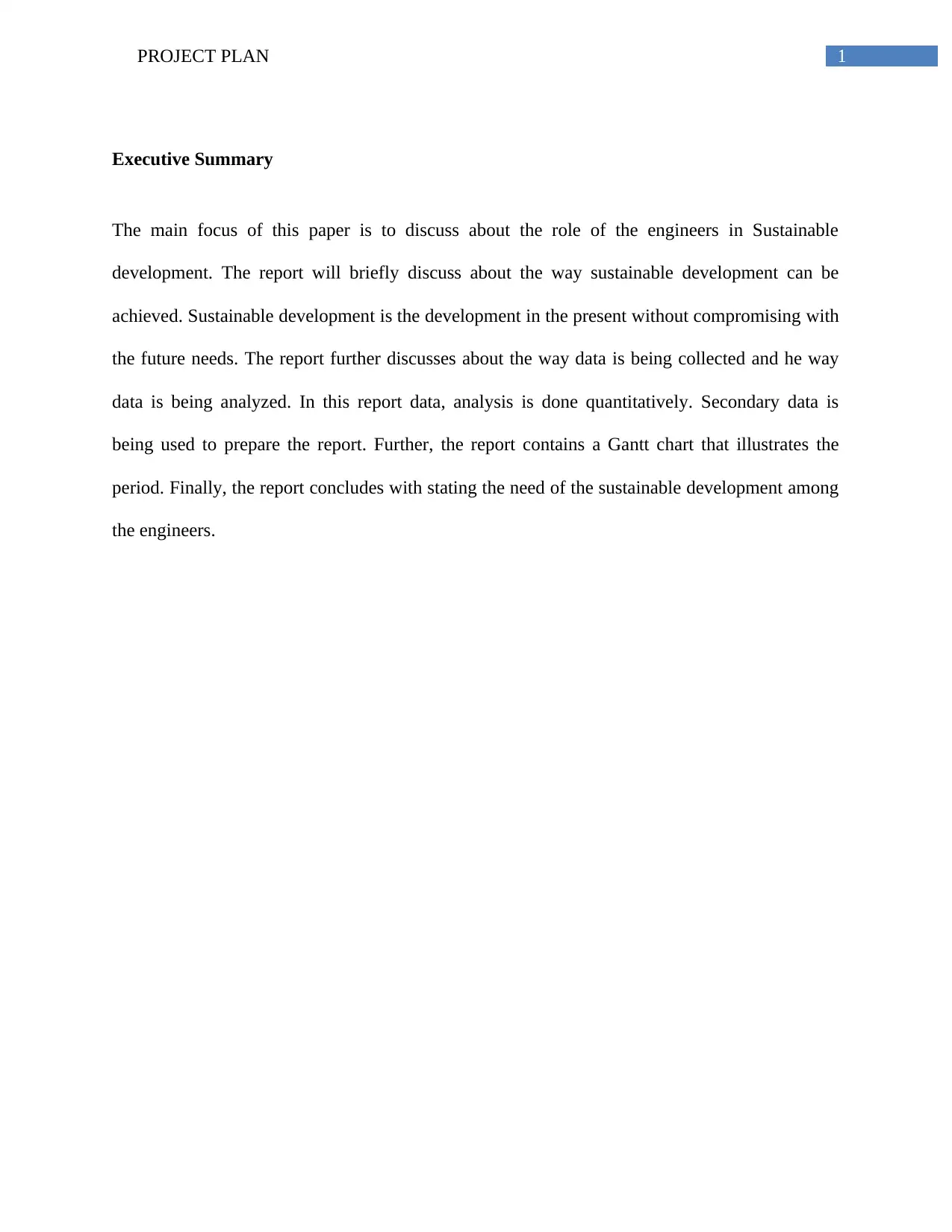
1PROJECT PLAN
Executive Summary
The main focus of this paper is to discuss about the role of the engineers in Sustainable
development. The report will briefly discuss about the way sustainable development can be
achieved. Sustainable development is the development in the present without compromising with
the future needs. The report further discusses about the way data is being collected and he way
data is being analyzed. In this report data, analysis is done quantitatively. Secondary data is
being used to prepare the report. Further, the report contains a Gantt chart that illustrates the
period. Finally, the report concludes with stating the need of the sustainable development among
the engineers.
Executive Summary
The main focus of this paper is to discuss about the role of the engineers in Sustainable
development. The report will briefly discuss about the way sustainable development can be
achieved. Sustainable development is the development in the present without compromising with
the future needs. The report further discusses about the way data is being collected and he way
data is being analyzed. In this report data, analysis is done quantitatively. Secondary data is
being used to prepare the report. Further, the report contains a Gantt chart that illustrates the
period. Finally, the report concludes with stating the need of the sustainable development among
the engineers.
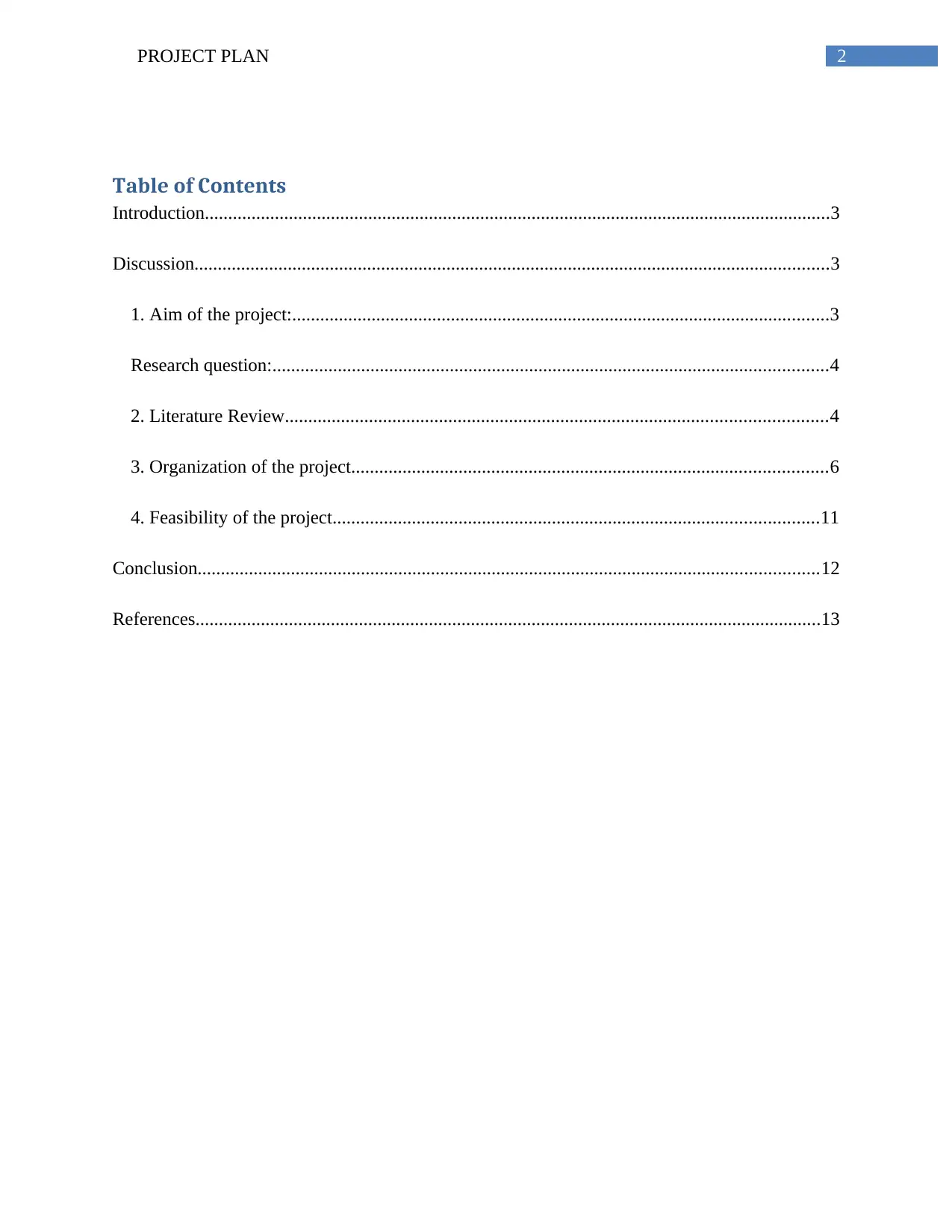
2PROJECT PLAN
Table of Contents
Introduction......................................................................................................................................3
Discussion........................................................................................................................................3
1. Aim of the project:...................................................................................................................3
Research question:.......................................................................................................................4
2. Literature Review....................................................................................................................4
3. Organization of the project......................................................................................................6
4. Feasibility of the project........................................................................................................11
Conclusion.....................................................................................................................................12
References......................................................................................................................................13
Table of Contents
Introduction......................................................................................................................................3
Discussion........................................................................................................................................3
1. Aim of the project:...................................................................................................................3
Research question:.......................................................................................................................4
2. Literature Review....................................................................................................................4
3. Organization of the project......................................................................................................6
4. Feasibility of the project........................................................................................................11
Conclusion.....................................................................................................................................12
References......................................................................................................................................13
⊘ This is a preview!⊘
Do you want full access?
Subscribe today to unlock all pages.

Trusted by 1+ million students worldwide

3PROJECT PLAN
Introduction
Sustainable development refers to the growth that meets the present requirement without
affecting the need of the generation. For an engineer, sustainable system is a system that either
changes in a slow rate or in equilibrium. The concept of sustainability is described best with the
help of natural ecosystem. This is described with the natural ecosystem as these changes slowly
in a closed loop. Engineers supports at each step of the sustainable development model :
• Number of waste generated can be reduced by processing resources in a closed loop. This
increases the efficiency of the resources.
• Resources can be preserved by recycling and reusing the designing. This lessens the impact on
the environment throughout their life cycle.
• Goods transport heavily pollutes the environment. In order to minimize the effects we can use
transport way that will cause less impact
• Developing of energy resources affects the atmosphere adversely. The effects caused to the
atmosphere can be reduced by efficiently use of energies and by using products from non-fossil
resources.
Discussion
1. Aim of the project:
The research aim is to identify and discuss about the role of the engineers in the
sustainable development. The purpose behind choosing this topic in engineering management is
Introduction
Sustainable development refers to the growth that meets the present requirement without
affecting the need of the generation. For an engineer, sustainable system is a system that either
changes in a slow rate or in equilibrium. The concept of sustainability is described best with the
help of natural ecosystem. This is described with the natural ecosystem as these changes slowly
in a closed loop. Engineers supports at each step of the sustainable development model :
• Number of waste generated can be reduced by processing resources in a closed loop. This
increases the efficiency of the resources.
• Resources can be preserved by recycling and reusing the designing. This lessens the impact on
the environment throughout their life cycle.
• Goods transport heavily pollutes the environment. In order to minimize the effects we can use
transport way that will cause less impact
• Developing of energy resources affects the atmosphere adversely. The effects caused to the
atmosphere can be reduced by efficiently use of energies and by using products from non-fossil
resources.
Discussion
1. Aim of the project:
The research aim is to identify and discuss about the role of the engineers in the
sustainable development. The purpose behind choosing this topic in engineering management is
Paraphrase This Document
Need a fresh take? Get an instant paraphrase of this document with our AI Paraphraser
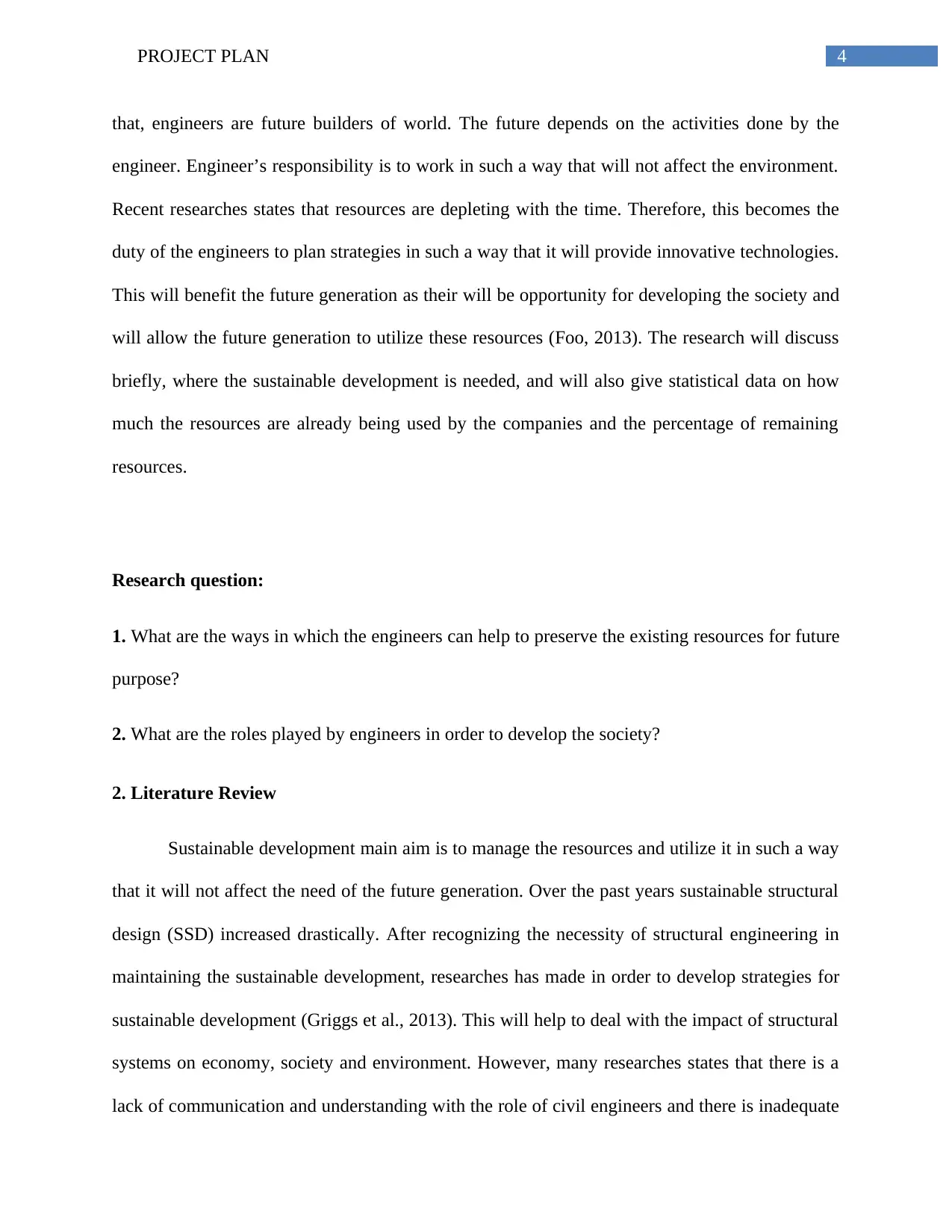
4PROJECT PLAN
that, engineers are future builders of world. The future depends on the activities done by the
engineer. Engineer’s responsibility is to work in such a way that will not affect the environment.
Recent researches states that resources are depleting with the time. Therefore, this becomes the
duty of the engineers to plan strategies in such a way that it will provide innovative technologies.
This will benefit the future generation as their will be opportunity for developing the society and
will allow the future generation to utilize these resources (Foo, 2013). The research will discuss
briefly, where the sustainable development is needed, and will also give statistical data on how
much the resources are already being used by the companies and the percentage of remaining
resources.
Research question:
1. What are the ways in which the engineers can help to preserve the existing resources for future
purpose?
2. What are the roles played by engineers in order to develop the society?
2. Literature Review
Sustainable development main aim is to manage the resources and utilize it in such a way
that it will not affect the need of the future generation. Over the past years sustainable structural
design (SSD) increased drastically. After recognizing the necessity of structural engineering in
maintaining the sustainable development, researches has made in order to develop strategies for
sustainable development (Griggs et al., 2013). This will help to deal with the impact of structural
systems on economy, society and environment. However, many researches states that there is a
lack of communication and understanding with the role of civil engineers and there is inadequate
that, engineers are future builders of world. The future depends on the activities done by the
engineer. Engineer’s responsibility is to work in such a way that will not affect the environment.
Recent researches states that resources are depleting with the time. Therefore, this becomes the
duty of the engineers to plan strategies in such a way that it will provide innovative technologies.
This will benefit the future generation as their will be opportunity for developing the society and
will allow the future generation to utilize these resources (Foo, 2013). The research will discuss
briefly, where the sustainable development is needed, and will also give statistical data on how
much the resources are already being used by the companies and the percentage of remaining
resources.
Research question:
1. What are the ways in which the engineers can help to preserve the existing resources for future
purpose?
2. What are the roles played by engineers in order to develop the society?
2. Literature Review
Sustainable development main aim is to manage the resources and utilize it in such a way
that it will not affect the need of the future generation. Over the past years sustainable structural
design (SSD) increased drastically. After recognizing the necessity of structural engineering in
maintaining the sustainable development, researches has made in order to develop strategies for
sustainable development (Griggs et al., 2013). This will help to deal with the impact of structural
systems on economy, society and environment. However, many researches states that there is a
lack of communication and understanding with the role of civil engineers and there is inadequate
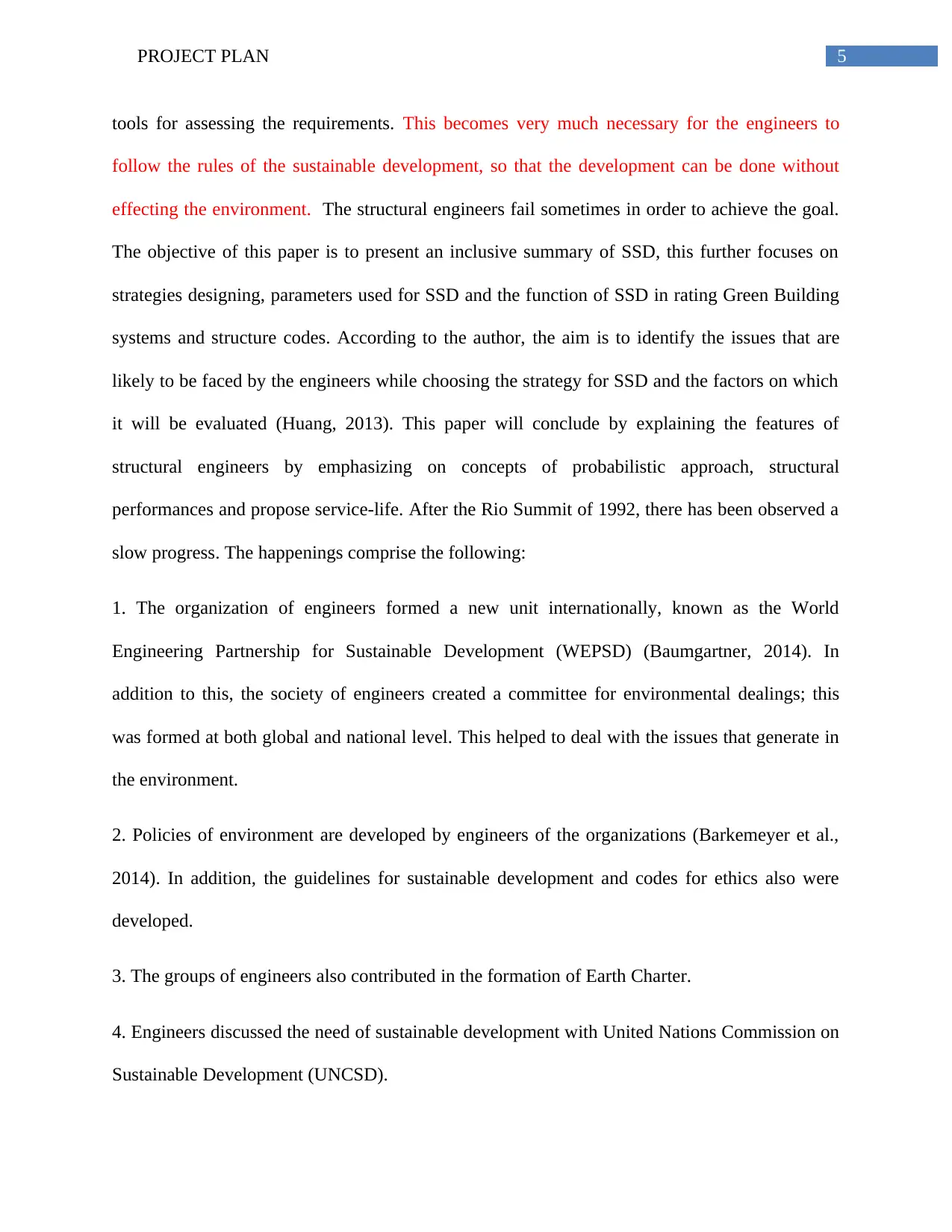
5PROJECT PLAN
tools for assessing the requirements. This becomes very much necessary for the engineers to
follow the rules of the sustainable development, so that the development can be done without
effecting the environment. The structural engineers fail sometimes in order to achieve the goal.
The objective of this paper is to present an inclusive summary of SSD, this further focuses on
strategies designing, parameters used for SSD and the function of SSD in rating Green Building
systems and structure codes. According to the author, the aim is to identify the issues that are
likely to be faced by the engineers while choosing the strategy for SSD and the factors on which
it will be evaluated (Huang, 2013). This paper will conclude by explaining the features of
structural engineers by emphasizing on concepts of probabilistic approach, structural
performances and propose service-life. After the Rio Summit of 1992, there has been observed a
slow progress. The happenings comprise the following:
1. The organization of engineers formed a new unit internationally, known as the World
Engineering Partnership for Sustainable Development (WEPSD) (Baumgartner, 2014). In
addition to this, the society of engineers created a committee for environmental dealings; this
was formed at both global and national level. This helped to deal with the issues that generate in
the environment.
2. Policies of environment are developed by engineers of the organizations (Barkemeyer et al.,
2014). In addition, the guidelines for sustainable development and codes for ethics also were
developed.
3. The groups of engineers also contributed in the formation of Earth Charter.
4. Engineers discussed the need of sustainable development with United Nations Commission on
Sustainable Development (UNCSD).
tools for assessing the requirements. This becomes very much necessary for the engineers to
follow the rules of the sustainable development, so that the development can be done without
effecting the environment. The structural engineers fail sometimes in order to achieve the goal.
The objective of this paper is to present an inclusive summary of SSD, this further focuses on
strategies designing, parameters used for SSD and the function of SSD in rating Green Building
systems and structure codes. According to the author, the aim is to identify the issues that are
likely to be faced by the engineers while choosing the strategy for SSD and the factors on which
it will be evaluated (Huang, 2013). This paper will conclude by explaining the features of
structural engineers by emphasizing on concepts of probabilistic approach, structural
performances and propose service-life. After the Rio Summit of 1992, there has been observed a
slow progress. The happenings comprise the following:
1. The organization of engineers formed a new unit internationally, known as the World
Engineering Partnership for Sustainable Development (WEPSD) (Baumgartner, 2014). In
addition to this, the society of engineers created a committee for environmental dealings; this
was formed at both global and national level. This helped to deal with the issues that generate in
the environment.
2. Policies of environment are developed by engineers of the organizations (Barkemeyer et al.,
2014). In addition, the guidelines for sustainable development and codes for ethics also were
developed.
3. The groups of engineers also contributed in the formation of Earth Charter.
4. Engineers discussed the need of sustainable development with United Nations Commission on
Sustainable Development (UNCSD).
⊘ This is a preview!⊘
Do you want full access?
Subscribe today to unlock all pages.

Trusted by 1+ million students worldwide
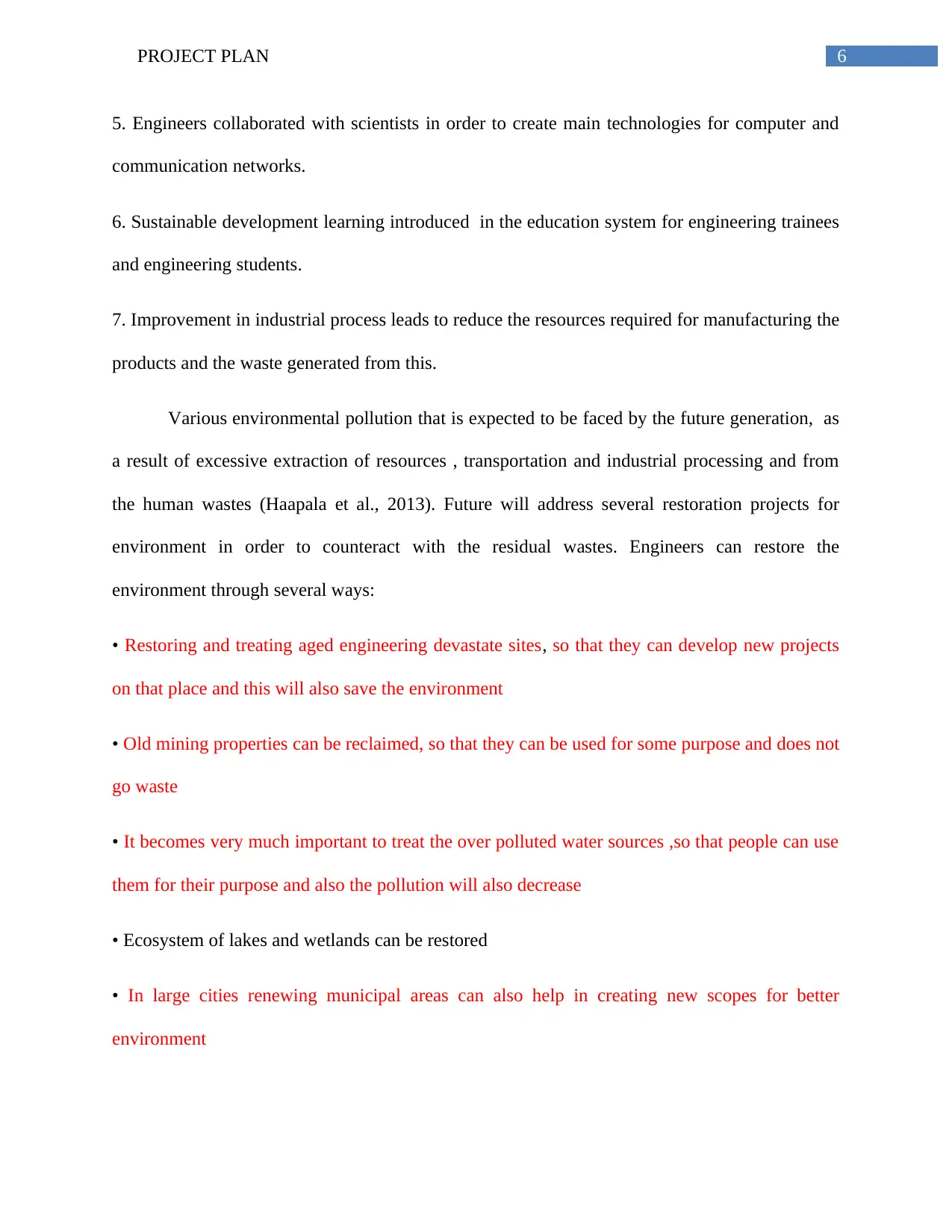
6PROJECT PLAN
5. Engineers collaborated with scientists in order to create main technologies for computer and
communication networks.
6. Sustainable development learning introduced in the education system for engineering trainees
and engineering students.
7. Improvement in industrial process leads to reduce the resources required for manufacturing the
products and the waste generated from this.
Various environmental pollution that is expected to be faced by the future generation, as
a result of excessive extraction of resources , transportation and industrial processing and from
the human wastes (Haapala et al., 2013). Future will address several restoration projects for
environment in order to counteract with the residual wastes. Engineers can restore the
environment through several ways:
• Restoring and treating aged engineering devastate sites, so that they can develop new projects
on that place and this will also save the environment
• Old mining properties can be reclaimed, so that they can be used for some purpose and does not
go waste
• It becomes very much important to treat the over polluted water sources ,so that people can use
them for their purpose and also the pollution will also decrease
• Ecosystem of lakes and wetlands can be restored
• In large cities renewing municipal areas can also help in creating new scopes for better
environment
5. Engineers collaborated with scientists in order to create main technologies for computer and
communication networks.
6. Sustainable development learning introduced in the education system for engineering trainees
and engineering students.
7. Improvement in industrial process leads to reduce the resources required for manufacturing the
products and the waste generated from this.
Various environmental pollution that is expected to be faced by the future generation, as
a result of excessive extraction of resources , transportation and industrial processing and from
the human wastes (Haapala et al., 2013). Future will address several restoration projects for
environment in order to counteract with the residual wastes. Engineers can restore the
environment through several ways:
• Restoring and treating aged engineering devastate sites, so that they can develop new projects
on that place and this will also save the environment
• Old mining properties can be reclaimed, so that they can be used for some purpose and does not
go waste
• It becomes very much important to treat the over polluted water sources ,so that people can use
them for their purpose and also the pollution will also decrease
• Ecosystem of lakes and wetlands can be restored
• In large cities renewing municipal areas can also help in creating new scopes for better
environment
Paraphrase This Document
Need a fresh take? Get an instant paraphrase of this document with our AI Paraphraser
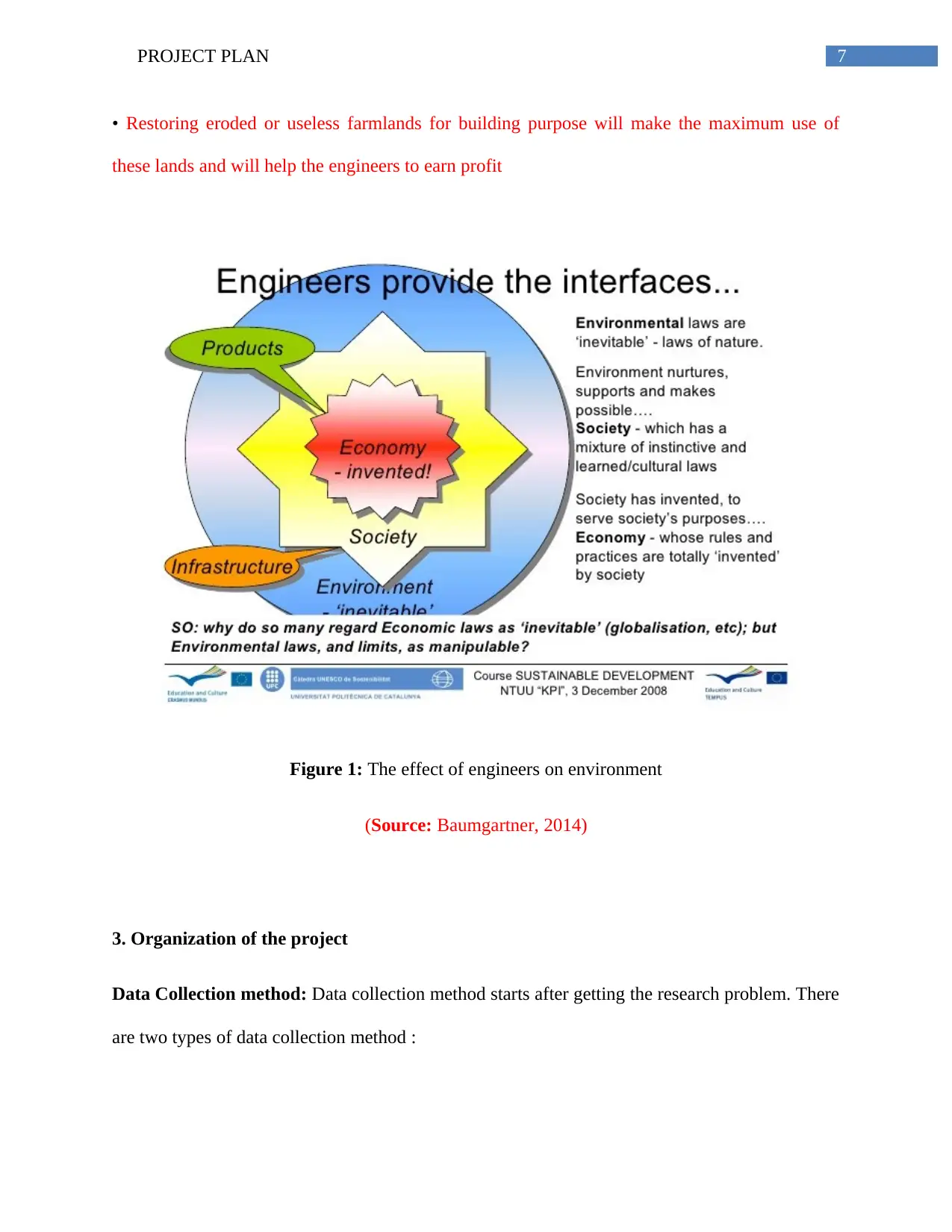
7PROJECT PLAN
• Restoring eroded or useless farmlands for building purpose will make the maximum use of
these lands and will help the engineers to earn profit
Figure 1: The effect of engineers on environment
(Source: Baumgartner, 2014)
3. Organization of the project
Data Collection method: Data collection method starts after getting the research problem. There
are two types of data collection method :
• Restoring eroded or useless farmlands for building purpose will make the maximum use of
these lands and will help the engineers to earn profit
Figure 1: The effect of engineers on environment
(Source: Baumgartner, 2014)
3. Organization of the project
Data Collection method: Data collection method starts after getting the research problem. There
are two types of data collection method :
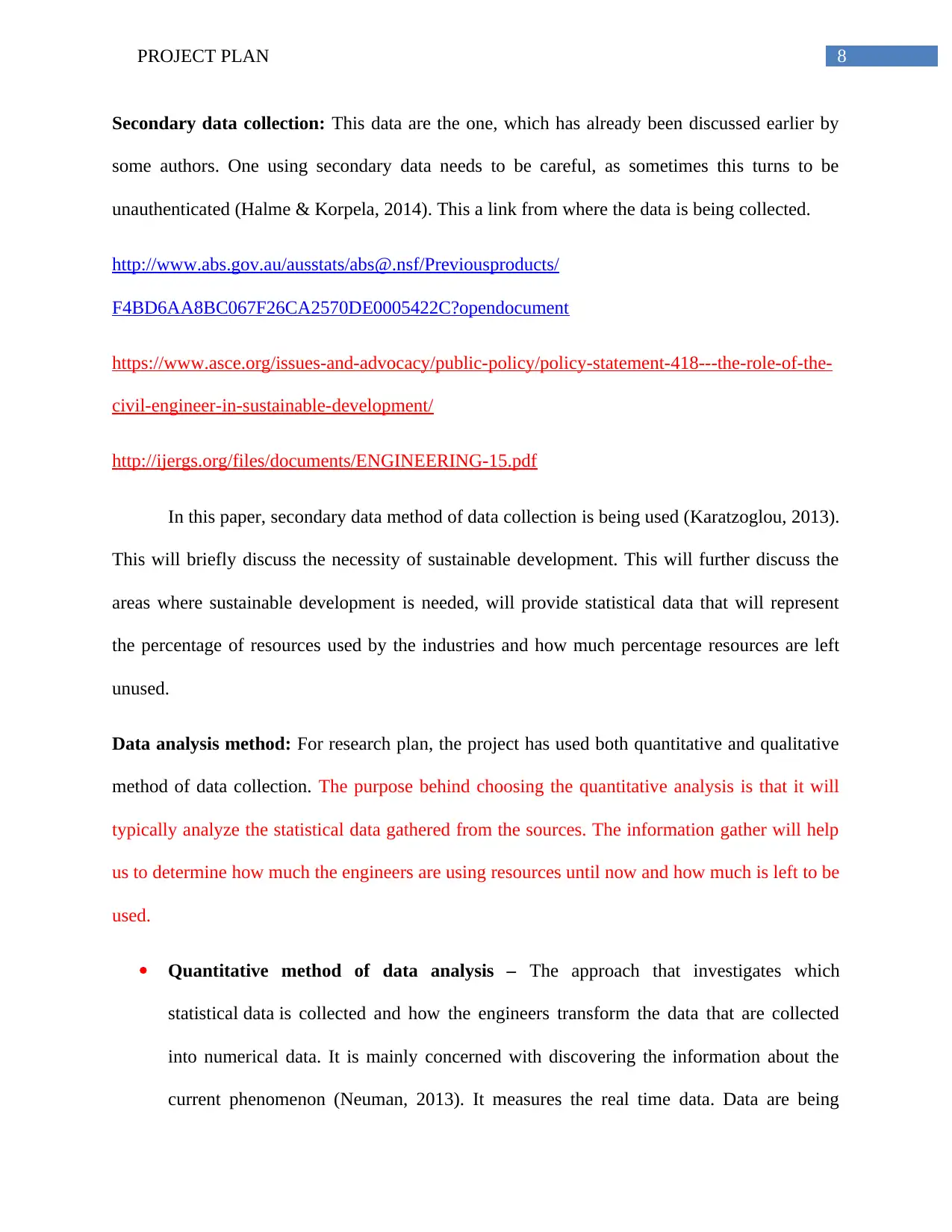
8PROJECT PLAN
Secondary data collection: This data are the one, which has already been discussed earlier by
some authors. One using secondary data needs to be careful, as sometimes this turns to be
unauthenticated (Halme & Korpela, 2014). This a link from where the data is being collected.
http://www.abs.gov.au/ausstats/abs@.nsf/Previousproducts/
F4BD6AA8BC067F26CA2570DE0005422C?opendocument
https://www.asce.org/issues-and-advocacy/public-policy/policy-statement-418---the-role-of-the-
civil-engineer-in-sustainable-development/
http://ijergs.org/files/documents/ENGINEERING-15.pdf
In this paper, secondary data method of data collection is being used (Karatzoglou, 2013).
This will briefly discuss the necessity of sustainable development. This will further discuss the
areas where sustainable development is needed, will provide statistical data that will represent
the percentage of resources used by the industries and how much percentage resources are left
unused.
Data analysis method: For research plan, the project has used both quantitative and qualitative
method of data collection. The purpose behind choosing the quantitative analysis is that it will
typically analyze the statistical data gathered from the sources. The information gather will help
us to determine how much the engineers are using resources until now and how much is left to be
used.
Quantitative method of data analysis – The approach that investigates which
statistical data is collected and how the engineers transform the data that are collected
into numerical data. It is mainly concerned with discovering the information about the
current phenomenon (Neuman, 2013). It measures the real time data. Data are being
Secondary data collection: This data are the one, which has already been discussed earlier by
some authors. One using secondary data needs to be careful, as sometimes this turns to be
unauthenticated (Halme & Korpela, 2014). This a link from where the data is being collected.
http://www.abs.gov.au/ausstats/abs@.nsf/Previousproducts/
F4BD6AA8BC067F26CA2570DE0005422C?opendocument
https://www.asce.org/issues-and-advocacy/public-policy/policy-statement-418---the-role-of-the-
civil-engineer-in-sustainable-development/
http://ijergs.org/files/documents/ENGINEERING-15.pdf
In this paper, secondary data method of data collection is being used (Karatzoglou, 2013).
This will briefly discuss the necessity of sustainable development. This will further discuss the
areas where sustainable development is needed, will provide statistical data that will represent
the percentage of resources used by the industries and how much percentage resources are left
unused.
Data analysis method: For research plan, the project has used both quantitative and qualitative
method of data collection. The purpose behind choosing the quantitative analysis is that it will
typically analyze the statistical data gathered from the sources. The information gather will help
us to determine how much the engineers are using resources until now and how much is left to be
used.
Quantitative method of data analysis – The approach that investigates which
statistical data is collected and how the engineers transform the data that are collected
into numerical data. It is mainly concerned with discovering the information about the
current phenomenon (Neuman, 2013). It measures the real time data. Data are being
⊘ This is a preview!⊘
Do you want full access?
Subscribe today to unlock all pages.

Trusted by 1+ million students worldwide
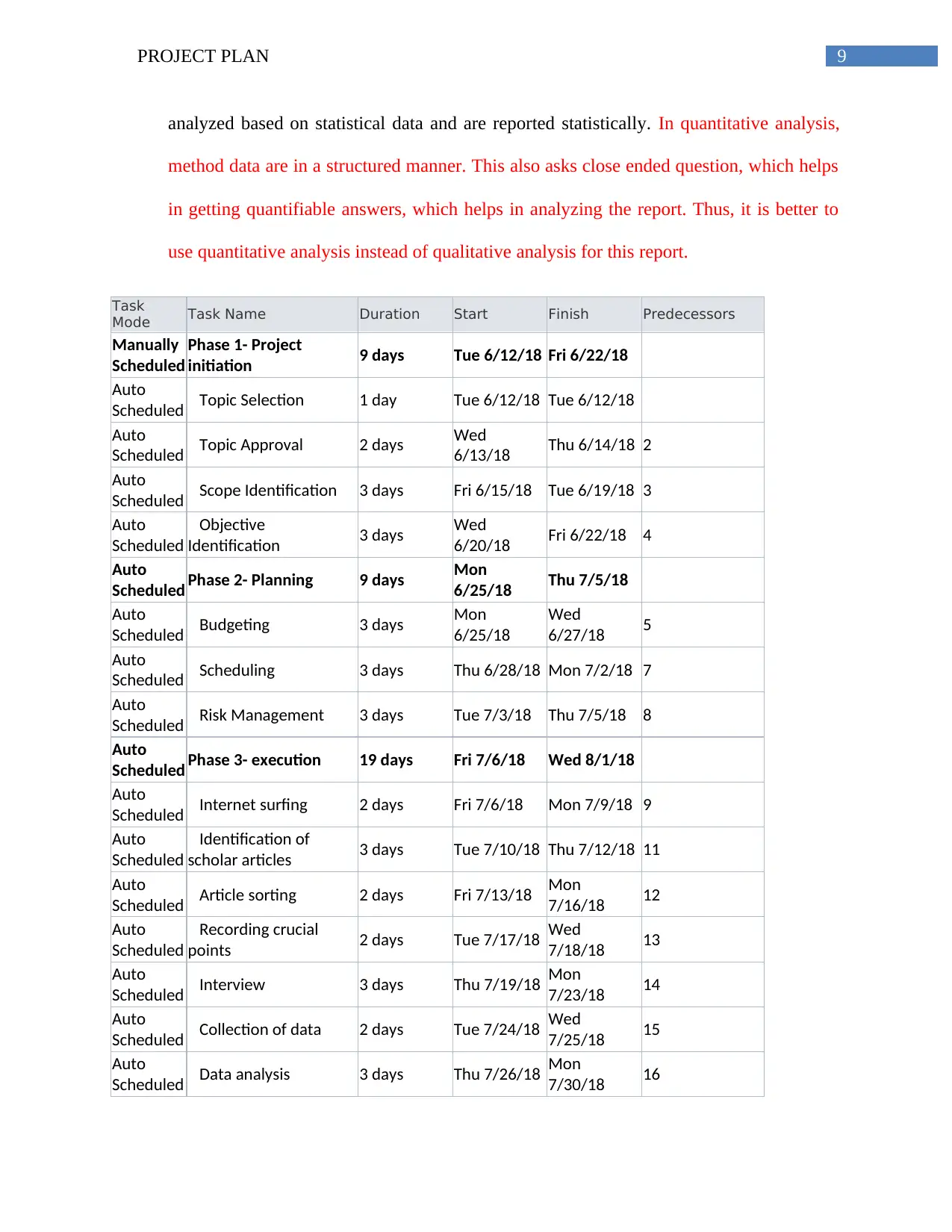
9PROJECT PLAN
analyzed based on statistical data and are reported statistically. In quantitative analysis,
method data are in a structured manner. This also asks close ended question, which helps
in getting quantifiable answers, which helps in analyzing the report. Thus, it is better to
use quantitative analysis instead of qualitative analysis for this report.
Task
Mode Task Name Duration Start Finish Predecessors
Manually
Scheduled
Phase 1- Project
initiation 9 days Tue 6/12/18 Fri 6/22/18
Auto
Scheduled Topic Selection 1 day Tue 6/12/18 Tue 6/12/18
Auto
Scheduled Topic Approval 2 days Wed
6/13/18 Thu 6/14/18 2
Auto
Scheduled Scope Identification 3 days Fri 6/15/18 Tue 6/19/18 3
Auto
Scheduled
Objective
Identification 3 days Wed
6/20/18 Fri 6/22/18 4
Auto
Scheduled Phase 2- Planning 9 days Mon
6/25/18 Thu 7/5/18
Auto
Scheduled Budgeting 3 days Mon
6/25/18
Wed
6/27/18 5
Auto
Scheduled Scheduling 3 days Thu 6/28/18 Mon 7/2/18 7
Auto
Scheduled Risk Management 3 days Tue 7/3/18 Thu 7/5/18 8
Auto
Scheduled Phase 3- execution 19 days Fri 7/6/18 Wed 8/1/18
Auto
Scheduled Internet surfing 2 days Fri 7/6/18 Mon 7/9/18 9
Auto
Scheduled
Identification of
scholar articles 3 days Tue 7/10/18 Thu 7/12/18 11
Auto
Scheduled Article sorting 2 days Fri 7/13/18 Mon
7/16/18 12
Auto
Scheduled
Recording crucial
points 2 days Tue 7/17/18 Wed
7/18/18 13
Auto
Scheduled Interview 3 days Thu 7/19/18 Mon
7/23/18 14
Auto
Scheduled Collection of data 2 days Tue 7/24/18 Wed
7/25/18 15
Auto
Scheduled Data analysis 3 days Thu 7/26/18 Mon
7/30/18 16
analyzed based on statistical data and are reported statistically. In quantitative analysis,
method data are in a structured manner. This also asks close ended question, which helps
in getting quantifiable answers, which helps in analyzing the report. Thus, it is better to
use quantitative analysis instead of qualitative analysis for this report.
Task
Mode Task Name Duration Start Finish Predecessors
Manually
Scheduled
Phase 1- Project
initiation 9 days Tue 6/12/18 Fri 6/22/18
Auto
Scheduled Topic Selection 1 day Tue 6/12/18 Tue 6/12/18
Auto
Scheduled Topic Approval 2 days Wed
6/13/18 Thu 6/14/18 2
Auto
Scheduled Scope Identification 3 days Fri 6/15/18 Tue 6/19/18 3
Auto
Scheduled
Objective
Identification 3 days Wed
6/20/18 Fri 6/22/18 4
Auto
Scheduled Phase 2- Planning 9 days Mon
6/25/18 Thu 7/5/18
Auto
Scheduled Budgeting 3 days Mon
6/25/18
Wed
6/27/18 5
Auto
Scheduled Scheduling 3 days Thu 6/28/18 Mon 7/2/18 7
Auto
Scheduled Risk Management 3 days Tue 7/3/18 Thu 7/5/18 8
Auto
Scheduled Phase 3- execution 19 days Fri 7/6/18 Wed 8/1/18
Auto
Scheduled Internet surfing 2 days Fri 7/6/18 Mon 7/9/18 9
Auto
Scheduled
Identification of
scholar articles 3 days Tue 7/10/18 Thu 7/12/18 11
Auto
Scheduled Article sorting 2 days Fri 7/13/18 Mon
7/16/18 12
Auto
Scheduled
Recording crucial
points 2 days Tue 7/17/18 Wed
7/18/18 13
Auto
Scheduled Interview 3 days Thu 7/19/18 Mon
7/23/18 14
Auto
Scheduled Collection of data 2 days Tue 7/24/18 Wed
7/25/18 15
Auto
Scheduled Data analysis 3 days Thu 7/26/18 Mon
7/30/18 16
Paraphrase This Document
Need a fresh take? Get an instant paraphrase of this document with our AI Paraphraser
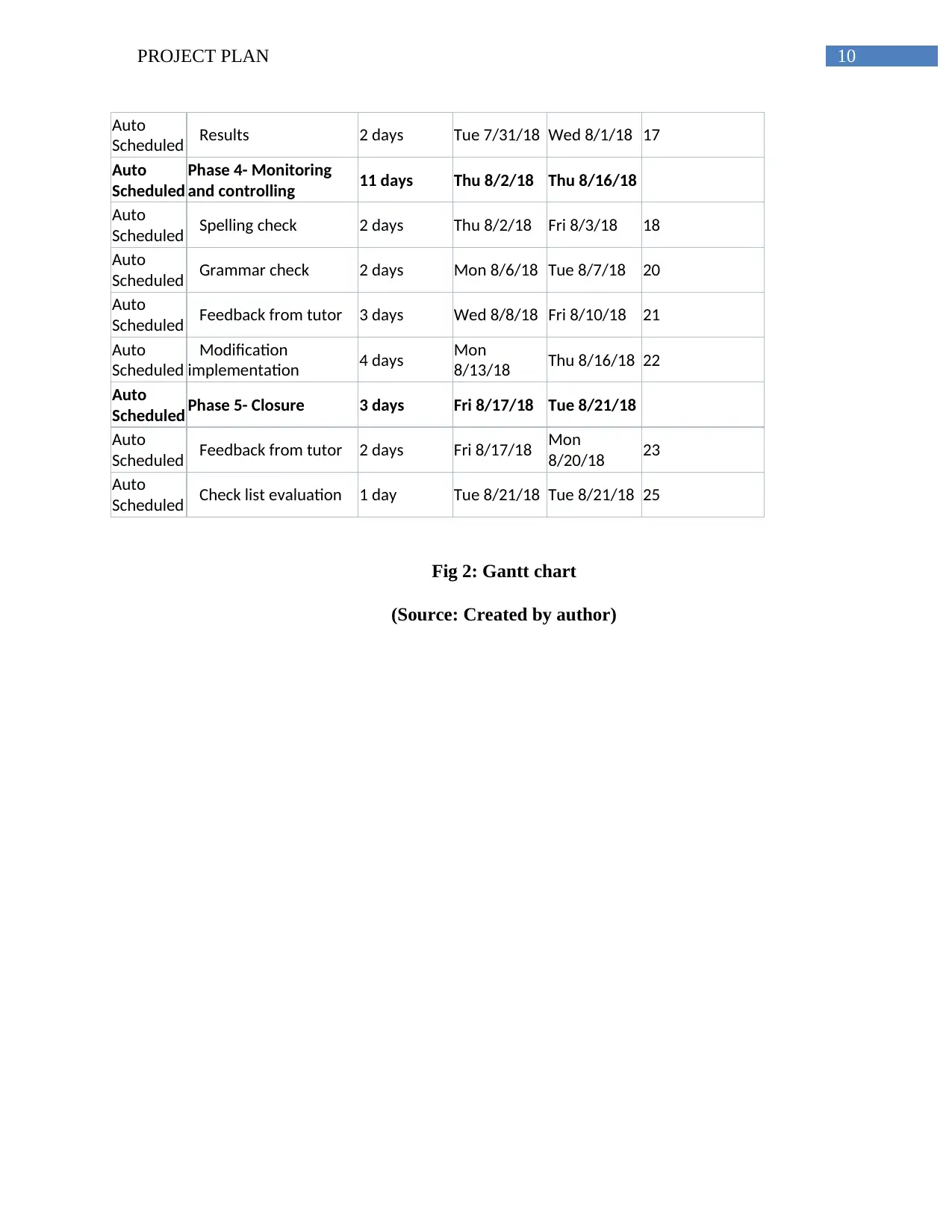
10PROJECT PLAN
Auto
Scheduled Results 2 days Tue 7/31/18 Wed 8/1/18 17
Auto
Scheduled
Phase 4- Monitoring
and controlling 11 days Thu 8/2/18 Thu 8/16/18
Auto
Scheduled Spelling check 2 days Thu 8/2/18 Fri 8/3/18 18
Auto
Scheduled Grammar check 2 days Mon 8/6/18 Tue 8/7/18 20
Auto
Scheduled Feedback from tutor 3 days Wed 8/8/18 Fri 8/10/18 21
Auto
Scheduled
Modification
implementation 4 days Mon
8/13/18 Thu 8/16/18 22
Auto
Scheduled Phase 5- Closure 3 days Fri 8/17/18 Tue 8/21/18
Auto
Scheduled Feedback from tutor 2 days Fri 8/17/18 Mon
8/20/18 23
Auto
Scheduled Check list evaluation 1 day Tue 8/21/18 Tue 8/21/18 25
Fig 2: Gantt chart
(Source: Created by author)
Auto
Scheduled Results 2 days Tue 7/31/18 Wed 8/1/18 17
Auto
Scheduled
Phase 4- Monitoring
and controlling 11 days Thu 8/2/18 Thu 8/16/18
Auto
Scheduled Spelling check 2 days Thu 8/2/18 Fri 8/3/18 18
Auto
Scheduled Grammar check 2 days Mon 8/6/18 Tue 8/7/18 20
Auto
Scheduled Feedback from tutor 3 days Wed 8/8/18 Fri 8/10/18 21
Auto
Scheduled
Modification
implementation 4 days Mon
8/13/18 Thu 8/16/18 22
Auto
Scheduled Phase 5- Closure 3 days Fri 8/17/18 Tue 8/21/18
Auto
Scheduled Feedback from tutor 2 days Fri 8/17/18 Mon
8/20/18 23
Auto
Scheduled Check list evaluation 1 day Tue 8/21/18 Tue 8/21/18 25
Fig 2: Gantt chart
(Source: Created by author)
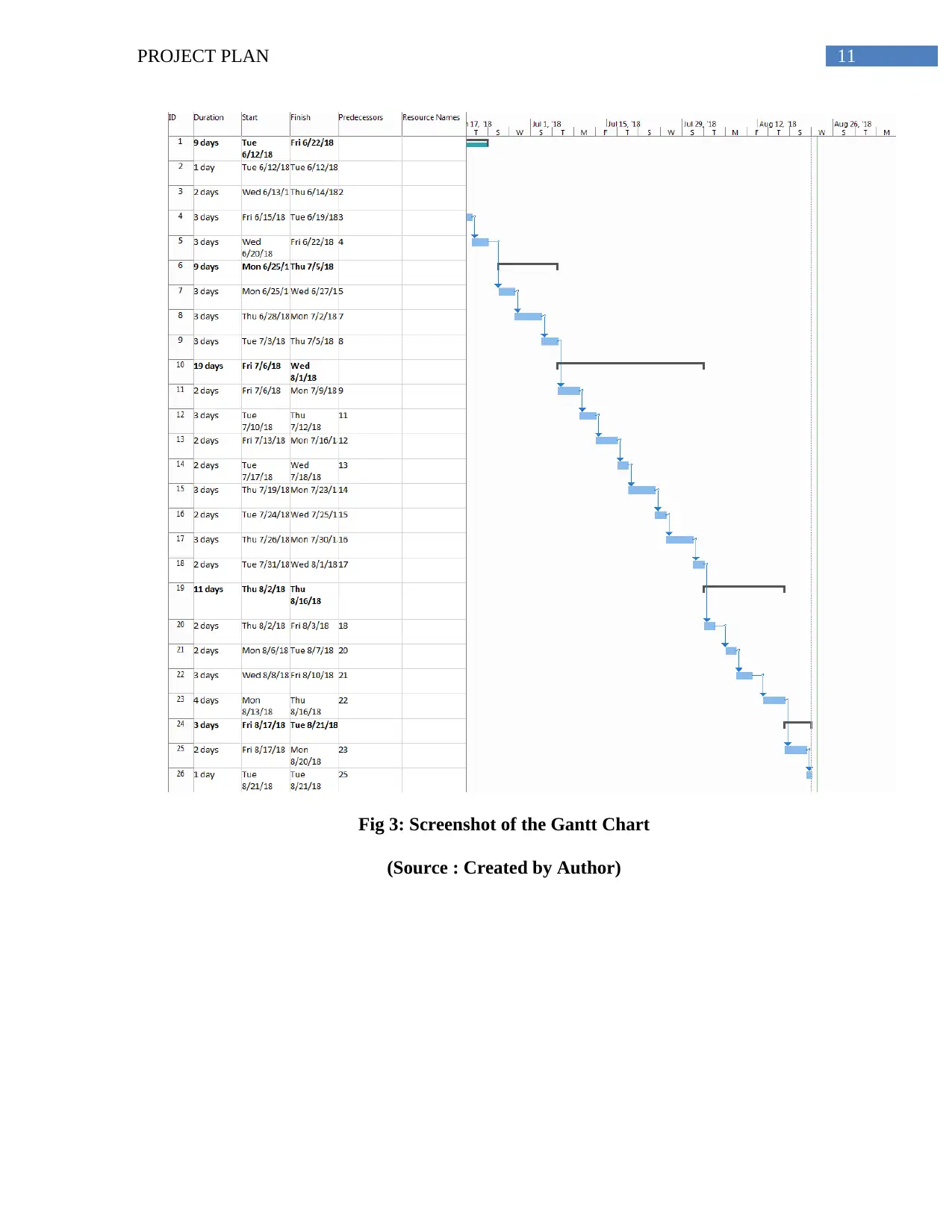
11PROJECT PLAN
Fig 3: Screenshot of the Gantt Chart
(Source : Created by Author)
Fig 3: Screenshot of the Gantt Chart
(Source : Created by Author)
⊘ This is a preview!⊘
Do you want full access?
Subscribe today to unlock all pages.

Trusted by 1+ million students worldwide
1 out of 17
Related Documents
Your All-in-One AI-Powered Toolkit for Academic Success.
+13062052269
info@desklib.com
Available 24*7 on WhatsApp / Email
![[object Object]](/_next/static/media/star-bottom.7253800d.svg)
Unlock your academic potential
Copyright © 2020–2025 A2Z Services. All Rights Reserved. Developed and managed by ZUCOL.





